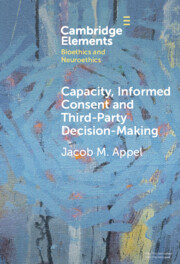130 results

Capacity, Informed Consent and Third-Party Decision-Making
-
- Published online:
- 03 June 2024
- Print publication:
- 31 July 2024
-
- Element
- Export citation
4 - Networks and Discrete Analysis
- from Part I - Tools and Theory
-
- Book:
- Harmonic Functions and Random Walks on Groups
- Published online:
- 16 May 2024
- Print publication:
- 23 May 2024, pp 117-158
-
- Chapter
- Export citation
3 - Laboring Bodies
- from Part I - Extraction and Abstraction
-
-
- Book:
- The Cambridge Companion to the Black Body in American Literature
- Published online:
- 09 May 2024
- Print publication:
- 16 May 2024, pp 49-61
-
- Chapter
- Export citation
Chapter 58 - Public Health and Pandemic Preparedness
- from Section 5 - Patient Management
-
- Book:
- Clinical and Diagnostic Virology
- Published online:
- 11 April 2024
- Print publication:
- 18 April 2024, pp 292-295
-
- Chapter
- Export citation
15 - Social and emotional competence for young children and educators
- from Part 3 - Social and emotional wellbeing
-
-
- Book:
- Health and Wellbeing in Childhood
- Published online:
- 08 March 2024
- Print publication:
- 04 March 2024, pp 241-256
-
- Chapter
- Export citation
43 - Decision-Making in Civil Matters
- from Part V - Other Legal Decision-Making
-
-
- Book:
- The Cambridge Handbook of Psychology and Legal Decision-Making
- Published online:
- 22 February 2024
- Print publication:
- 29 February 2024, pp 664-674
-
- Chapter
- Export citation
9 - Adolescent Autonomy
-
- Book:
- Fortin's Children's Rights and the Developing Law
- Published online:
- 08 February 2024
- Print publication:
- 29 February 2024, pp 339-371
-
- Chapter
- Export citation
Identifying core global mental health professional competencies: A multi-sectoral perspective
-
- Journal:
- Cambridge Prisms: Global Mental Health / Volume 11 / 2024
- Published online by Cambridge University Press:
- 22 February 2024, e24
-
- Article
-
- You have access
- Open access
- HTML
- Export citation
4 - A Trust-Based Framework for Enforcing Social Rights?
-
- Book:
- Trust, Courts and Social Rights
- Published online:
- 08 February 2024
- Print publication:
- 15 February 2024, pp 83-126
-
- Chapter
- Export citation
Birth: A radically new meditation for philosophy
-
- Article
-
- You have access
- Open access
- HTML
- Export citation
Priority skills for equity-focused, evidence-based cancer control in community-based organizations: A group concept mapping analysis with academics and practitioners
-
- Journal:
- Journal of Clinical and Translational Science / Volume 7 / Issue 1 / 2023
- Published online by Cambridge University Press:
- 10 July 2023, e164
-
- Article
-
- You have access
- Open access
- HTML
- Export citation
4 - Capacity and Authority to Contract
-
- Book:
- Contract Law of Qatar
- Published online:
- 15 June 2023
- Print publication:
- 29 June 2023, pp 45-67
-
- Chapter
-
- You have access
- Open access
- HTML
- Export citation
Decisional Capacity After Dark: Is Autonomy Delayed Truly Autonomy Denied?
-
- Journal:
- Cambridge Quarterly of Healthcare Ethics / Volume 33 / Issue 2 / April 2024
- Published online by Cambridge University Press:
- 27 June 2023, pp. 260-266
-
- Article
- Export citation
10 - Informed Consent to Research
- from Part II - The Building Blocks of a Study
-
-
- Book:
- The Cambridge Handbook of Research Methods and Statistics for the Social and Behavioral Sciences
- Published online:
- 25 May 2023
- Print publication:
- 08 June 2023, pp 202-223
-
- Chapter
- Export citation
Assessing mental capacity: tensions, values and duties
-
- Journal:
- BJPsych Advances / Volume 30 / Issue 1 / January 2024
- Published online by Cambridge University Press:
- 06 June 2023, pp. 21-23
- Print publication:
- January 2024
-
- Article
- Export citation
Introduction
-
-
- Book:
- Shakespeare and Virtue
- Published online:
- 19 January 2023
- Print publication:
- 26 January 2023, pp 1-18
-
- Chapter
- Export citation
Chapter 34 - Globability
- from Part III - Shakespeare and Global Virtue Traditions
-
-
- Book:
- Shakespeare and Virtue
- Published online:
- 19 January 2023
- Print publication:
- 26 January 2023, pp 334-346
-
- Chapter
- Export citation
8 - Helping Farmers Make Better Decisions Using Climate Services
-
-
- Book:
- Transforming Food Systems Under Climate Change through Innovation
- Published online:
- 19 January 2023
- Print publication:
- 19 January 2023, pp 75-88
-
- Chapter
-
- You have access
- Open access
- HTML
- Export citation
11 - Policies and Design Processes to Enable Transformation
-
-
- Book:
- Transforming Food Systems Under Climate Change through Innovation
- Published online:
- 19 January 2023
- Print publication:
- 19 January 2023, pp 119-129
-
- Chapter
-
- You have access
- Open access
- HTML
- Export citation
18 - A New Vision for Leadership in Food Systems Research
-
-
- Book:
- Transforming Food Systems Under Climate Change through Innovation
- Published online:
- 19 January 2023
- Print publication:
- 19 January 2023, pp 209-218
-
- Chapter
-
- You have access
- Open access
- HTML
- Export citation



